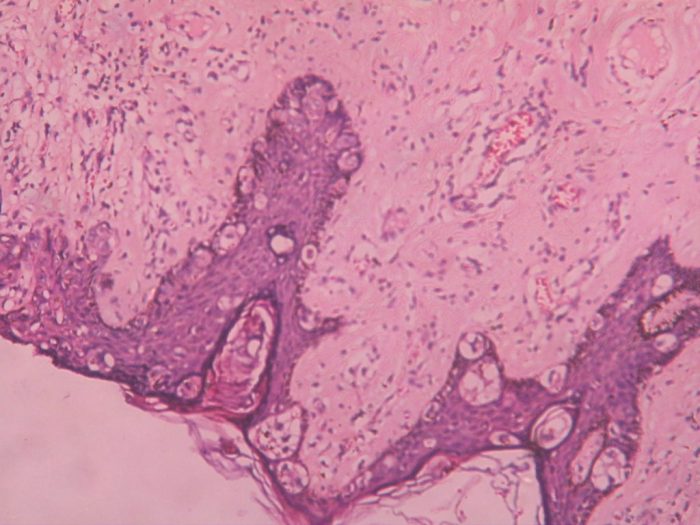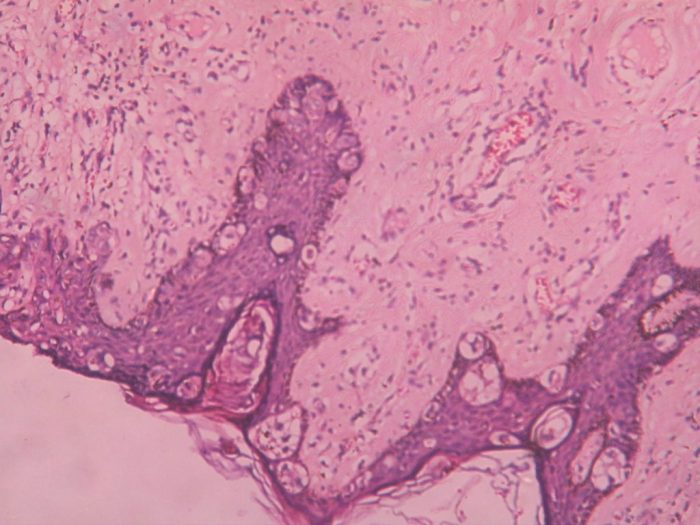Pagets disease of the breast – Paget’s disease of the breast is a rare skin condition that often presents as a rash or eczema-like lesion on the nipple or areola. Understanding this condition, from its characteristics to treatment options, is crucial for early diagnosis and effective management. This comprehensive guide delves into the intricacies of Paget’s disease, offering insights into its causes, diagnosis, and potential treatment strategies.
This condition can sometimes be confused with other skin conditions, making early diagnosis challenging. The symptoms often present subtly, and a thorough evaluation by a healthcare professional is essential for proper assessment and treatment planning. We’ll explore the risk factors, potential complications, and the importance of ongoing monitoring in managing this disease.
Introduction to Paget’s Disease of the Breast
Paget’s disease of the breast is a rare form of breast cancer that typically presents as a skin lesion on the nipple or areola. It’s characterized by changes in the skin of the nipple and areola, often mimicking eczema or other skin conditions. Understanding its characteristics, risk factors, and presentation is crucial for early detection and appropriate management.Paget’s disease of the breast is a distinct type of breast cancer that primarily affects the skin of the nipple and areola.
It’s important to note that this condition is not a separate entity but rather a manifestation of underlying invasive or non-invasive breast cancer. The cancerous cells infiltrate the skin, causing the characteristic symptoms.
Key Characteristics and Features
Paget’s disease of the breast is primarily recognized by its cutaneous presentation. The cancerous cells migrate along the ducts of the breast, ultimately reaching the nipple and areola, where they cause skin changes. These cells can also invade the underlying breast tissue. Key features include erythema (redness), scaling, crusting, itching, and pain. The lesions are often asymmetrical and can be mistaken for other skin conditions.
Risk Factors
Several factors can increase the likelihood of developing Paget’s disease of the breast. While a definitive cause isn’t always established, factors such as a family history of breast cancer, a personal history of breast cancer, and genetic predispositions like BRCA mutations are known risk factors. Age also plays a role, with the disease most commonly affecting women in their 50s and 60s.
Paget’s disease of the breast is a rare and aggressive form of breast cancer. While there’s no proven connection to a fatty liver, maintaining a healthy liver is crucial for overall well-being, and exploring natural remedies for fatty liver prevention might offer some supportive strategies. For example, incorporating a diet rich in fruits, vegetables, and lean protein, as well as regular exercise, can play a vital role in promoting liver health and potentially influencing other aspects of your overall health.
These preventative measures might indirectly benefit individuals facing Paget’s disease of the breast by supporting their general health and well-being. natural remedies for fatty liver prevention
A history of benign breast conditions may also be a contributing factor.
Typical Presentation and Symptoms
The typical presentation of Paget’s disease of the breast often begins with subtle changes in the nipple and areola. Initial symptoms may include itching, scaling, or crusting, which may be mistaken for eczema or other skin conditions. The skin may also appear red, inflamed, or thickened. As the disease progresses, the symptoms become more pronounced, potentially leading to pain, bleeding, or discharge from the nipple.
It’s crucial to remember that these symptoms can vary significantly from person to person.
Stages of Paget’s Disease
Staging Paget’s disease of the breast often depends on the extent of the underlying breast cancer. While not explicitly categorized like other cancers, it’s often assessed within the context of the more common staging systems for breast cancer. The stage reflects the size and location of the primary tumor, the presence of lymph node involvement, and the presence of distant metastases.
This assessment is typically performed by a medical professional, and treatment strategies are tailored to the specific stage.
Comparison with Other Breast Conditions
| Condition | Key Characteristics | Symptoms |
|---|---|---|
| Paget’s Disease of the Breast | Skin changes on the nipple/areola, often mimicking eczema; associated with underlying breast cancer. | Itching, scaling, crusting, redness, pain, bleeding, or discharge from the nipple. |
| Breast Cancer (Invasive Ductal Carcinoma) | Cancerous cells invade the milk ducts. | May include a lump, thickening, dimpling of the skin, changes in nipple shape, or discharge. |
| Fibrocystic Breast Disease | Benign condition characterized by fibrous and cystic tissue changes. | Lumpiness, tenderness, and cyclical pain, often linked to hormonal changes. |
Pathophysiology and Etiology
Paget’s disease of the breast, a perplexing condition, remains a subject of ongoing investigation. Understanding the underlying mechanisms, or pathophysiology, is crucial for developing effective treatments and improving patient outcomes. The interplay of cellular and molecular processes, along with potential causes and risk factors, shapes our understanding of this disease. This section delves into the current knowledge surrounding Paget’s disease of the breast, focusing on its complex etiology and relationship with underlying breast cancer.The exact mechanisms driving Paget’s disease of the breast are not fully elucidated.
However, prevailing theories point to a complex interplay of genetic predisposition, hormonal influences, and environmental factors. It’s important to acknowledge the intricate dance between cellular events and the potential for this disease to be associated with an underlying invasive carcinoma.
Cellular and Molecular Processes
Paget’s cells, the hallmark of this disease, are atypical epithelial cells found in the epidermis of the nipple and areola. These cells exhibit unique morphological characteristics, including increased size, and demonstrate specific molecular alterations. One critical area of investigation focuses on the dysregulation of signaling pathways, such as the Wnt pathway and the epidermal growth factor receptor (EGFR) signaling pathway, which may contribute to the development and progression of Paget’s cells.
Mutations in these pathways can disrupt normal cellular function, leading to uncontrolled cell growth and proliferation.
Potential Causes and Risk Factors
While a definitive cause for Paget’s disease of the breast remains elusive, various risk factors are associated with its development. A family history of breast cancer is a significant risk factor, suggesting a potential genetic predisposition. Moreover, hormonal influences, including estrogen levels and hormonal imbalances, are thought to play a role in the disease’s etiology. Environmental factors, such as exposure to carcinogens or certain lifestyle choices, could also contribute.
However, it’s crucial to remember that the precise interplay between these factors remains under investigation.
Paget’s disease of the breast, a rare condition, can sometimes be a tricky one to diagnose. It often presents with skin changes on the nipple and areola, but underlying issues like atypical ductal hyperplasia of the breast can sometimes be a contributing factor. It’s important to remember that Paget’s disease is often a sign of a more serious issue, so early detection and appropriate medical care are key.
Comparison of Pathogenesis Theories
Current theories regarding the pathogenesis of Paget’s disease of the breast often center around the idea that it arises from an underlying, often occult, invasive ductal carcinoma. However, some researchers suggest that Paget’s disease may sometimes be an independent process. This suggests a potential difference in cellular origins and mechanisms for the disease, prompting further research into the possible existence of distinct subtypes of Paget’s disease.
A crucial area of future research is the development of biomarkers to distinguish between these possibilities.
Relationship Between Paget’s Disease and Underlying Breast Cancer
In the majority of cases, Paget’s disease of the breast is linked to an underlying invasive ductal carcinoma. This association highlights the importance of early detection and thorough diagnostic evaluations to identify and address any associated breast cancer. The presence of Paget’s disease often signifies a more advanced stage of breast cancer compared to other forms of presentation.
Early intervention and aggressive treatment strategies are crucial for improved outcomes.
Types of Paget’s Disease of the Breast
Different subtypes of Paget’s disease of the breast may exist, with varied clinical presentations and prognoses. The heterogeneity of the disease warrants a detailed classification system to better understand and manage it.
| Type | Description | Prevalence |
|---|---|---|
| Type A | Characterized by the presence of an underlying invasive ductal carcinoma. Usually presents as an early stage breast cancer, often with a higher survival rate. | More common |
| Type B | This type may represent an independent process without an underlying invasive ductal carcinoma. Its prevalence is lower compared to Type A, and often presents with a less favorable prognosis. | Less common |
Diagnosis and Assessment
Unveiling Paget’s disease of the breast requires a multi-faceted approach, combining meticulous clinical evaluation with sophisticated diagnostic tools. A thorough understanding of the disease’s presentation, coupled with appropriate investigations, is crucial for accurate diagnosis and subsequent treatment planning. Early and precise diagnosis allows for timely intervention, potentially impacting patient outcomes positively.
Diagnostic Procedures for Paget’s Disease
The diagnostic journey for Paget’s disease of the breast begins with a comprehensive evaluation of the patient’s symptoms and medical history. This is followed by a physical examination, which focuses on identifying the characteristic skin changes, such as eczema-like lesions, often localized to the nipple and areola. These findings, along with the patient’s history, provide initial clues about the possibility of Paget’s disease.
Imaging Techniques
Imaging plays a vital role in assessing the extent of the disease and identifying any associated abnormalities. Mammography is frequently employed to evaluate the breast tissue for any underlying masses or architectural distortions. Ultrasound can provide further details about the nature of any suspicious lesions detected on mammography. In certain cases, magnetic resonance imaging (MRI) might be employed to gain a more comprehensive view of the breast anatomy and potential involvement of surrounding tissues.
These imaging techniques help to delineate the extent of the disease and guide subsequent biopsies.
Histopathological Examination
Histopathological examination is paramount in confirming the diagnosis of Paget’s disease. A tissue sample, often obtained through a biopsy, is examined under a microscope. Microscopic analysis reveals characteristic features of Paget’s cells, including their location within the epidermis, their cytological characteristics, and their atypical appearance. The presence of these specific features confirms the diagnosis of Paget’s disease.
The histopathological evaluation provides crucial information for staging the disease and guiding therapeutic decisions.
Role of Diagnostic Markers
While not routinely used as primary diagnostic tools, certain biomarkers can potentially aid in the diagnostic process. For example, immunohistochemical stains can highlight the presence of specific proteins, such as cytokeratin 7 and 20, in the Paget cells. The presence of these markers can help confirm the diagnosis and differentiate Paget’s disease from other skin conditions.
Step-by-Step Procedure for Diagnosis
A systematic approach to diagnosis is essential. A detailed patient history, including symptoms, medical history, and family history, is initially gathered. Physical examination of the affected area is performed, noting any skin changes or lesions. Imaging studies, including mammography and ultrasound, are used to assess the breast tissue and identify any suspicious lesions. A biopsy is then performed to obtain tissue samples for histopathological examination.
Immunohistochemical analysis can further aid in confirming the diagnosis. Finally, a comprehensive evaluation of the results and clinical findings leads to the definitive diagnosis.
Diagnostic Flowchart
Patient Presentation --> History & Physical Exam
|
V
Suspicion of Paget's Disease --> Imaging Studies (Mammography, Ultrasound, MRI)
|
V
Suspicious Lesion Detected --> Biopsy
|
V
Histopathological Examination
|
V
Confirmation of Paget's Disease or Other Diagnosis
Treatment Strategies

Paget’s disease of the breast, while often a localized condition, requires a multifaceted approach to treatment.
Successful management hinges on a tailored strategy that considers the extent of the disease, the patient’s overall health, and their preferences. The goal is not just to eradicate the disease but also to minimize potential side effects and preserve quality of life.
Surgical Approaches, Pagets disease of the breast
Surgical intervention is frequently a cornerstone of treatment for Paget’s disease. The specific surgical approach depends on several factors, including the extent of the Paget’s disease, the presence of underlying breast cancer, and the patient’s overall health. Lumpectomy, a procedure that removes only the affected area, is a viable option if the disease is confined to a small region and if there’s no evidence of invasive cancer.
However, if the disease has spread beyond the immediate area or if invasive cancer is suspected, a mastectomy, the removal of the entire breast, may be necessary. In some cases, sentinel lymph node biopsy may be performed to determine if the cancer has spread to the lymph nodes. The choice between lumpectomy and mastectomy is often made in consultation with a surgeon and oncologist.
Adjuvant Therapies
Adjuvant therapies are often employed alongside surgery to reduce the risk of recurrence and improve overall outcomes. These therapies aim to eliminate any remaining cancer cells that may not have been detected during surgery. Radiation therapy is a common adjuvant treatment, delivering targeted radiation to the affected area to kill any remaining cancer cells. Systemic therapies, including chemotherapy and hormonal therapy, are used if the cancer has spread or if there’s a high risk of recurrence.
The type and duration of adjuvant therapy depend on the individual characteristics of the disease and the patient.
Potential Side Effects
Treatment for Paget’s disease, like any medical intervention, carries potential side effects. Surgical procedures, such as mastectomies, can result in scarring, pain, and temporary changes in body image. Radiation therapy can cause skin irritation, fatigue, and a risk of long-term complications. Chemotherapy can cause nausea, hair loss, and other systemic side effects. Hormonal therapies may lead to menopausal symptoms or other hormonal imbalances.
It’s crucial for patients to discuss potential side effects with their healthcare team and explore strategies to mitigate them.
Summary of Treatment Modalities
Treatment for Paget’s disease of the breast typically involves a combination of surgery, potentially including sentinel lymph node biopsy, followed by adjuvant therapies like radiation and, in some cases, chemotherapy or hormonal therapy. The specific treatment plan is individualized based on the extent of the disease, the presence of underlying invasive breast cancer, and the patient’s overall health. Careful consideration of potential side effects and a collaborative approach between the patient and their healthcare team are paramount to ensure optimal outcomes.
Comparison of Treatment Options
Choosing the right treatment for Paget’s disease of the breast is a personalized decision. A patient with early-stage Paget’s disease without underlying invasive cancer might opt for lumpectomy followed by radiation. Conversely, a patient with extensive Paget’s disease or suspected invasive cancer would likely undergo mastectomy and possibly additional adjuvant therapies. Patient factors, such as age, overall health, and personal preferences, play a significant role in the decision-making process.
Treatment Options Table
| Treatment | Description | Effectiveness | Side Effects |
|---|---|---|---|
| Surgery (lumpectomy/mastectomy) | Removal of the affected breast tissue. | Highly effective in localized disease. Success rate varies depending on the stage and presence of invasive cancer. | Scarring, pain, temporary body image changes. Risk of complications from surgery. |
| Radiation Therapy | Targeted radiation to the affected area. | Effective in reducing recurrence rates. | Skin irritation, fatigue, risk of long-term complications. |
| Chemotherapy | Systemic drug treatment to kill cancer cells. | Effective for advanced or high-risk disease. | Nausea, hair loss, fatigue, other systemic side effects. |
| Hormonal Therapy | Medication to block or reduce hormone activity. | Effective for hormone receptor-positive cancers. | Menopausal symptoms, hormonal imbalances. |
Prognosis and Follow-up: Pagets Disease Of The Breast

Paget’s disease of the breast, while often treatable, necessitates a long-term approach to ensure optimal outcomes. Understanding the prognosis, the factors influencing it, and the crucial role of follow-up care is paramount for both patients and healthcare providers. This section delves into the specifics of managing Paget’s disease, emphasizing the importance of consistent monitoring and early intervention.
The prognosis for Paget’s disease of the breast is generally good, especially when detected and treated early. However, the presence of underlying invasive breast cancer significantly impacts the outlook. The prognosis is closely tied to the extent of the disease, including the presence of invasive carcinoma and the extent of any associated lymph node involvement. Early detection and prompt treatment significantly improve the chances of a positive outcome.
Real-life examples include patients who, upon early diagnosis and aggressive treatment, experience complete remission and long-term survival.
Factors Influencing Prognosis
Several factors influence the prognosis of Paget’s disease. The presence of underlying invasive breast cancer is a key determinant, as it signifies a more aggressive disease course. The extent of the Paget’s disease itself, including the size and location of the affected area, also plays a significant role. Other factors such as the patient’s overall health, age, and response to treatment can also influence the prognosis.
For example, a younger patient with a robust immune system and quick response to therapy is more likely to experience a favorable outcome compared to an older patient with pre-existing health conditions.
Paget’s disease of the breast, while often overlooked, can sometimes manifest in unusual ways. One of these is the experience of waking up with numb hands, a symptom that could be a sign of other health issues. It’s crucial to remember that this symptom alone isn’t definitive of Paget’s disease, and a proper medical evaluation is necessary. Seeking advice from a healthcare professional is always recommended when experiencing unusual symptoms like this.
Further research into Paget’s disease of the breast can provide more information about potential symptoms and appropriate next steps, such as consulting a doctor. Waking up with numb hands can have a variety of causes, so a medical evaluation is vital to properly diagnose and address any potential underlying conditions.
Importance of Long-Term Follow-Up Care
Long-term follow-up care is crucial for patients diagnosed with Paget’s disease. Regular monitoring allows for early detection of any recurrence or development of other related conditions. This proactive approach is vital in maintaining the patient’s well-being and optimizing treatment efficacy. Without consistent monitoring, the risk of recurrence or the development of complications increases significantly.
Potential Complications
Potential complications associated with Paget’s disease of the breast include, but are not limited to, the development of invasive breast cancer, recurrence of Paget’s disease, and complications from the treatment itself. Treatment side effects may include pain, skin irritation, or scarring.
Importance of Regular Monitoring for Recurrence
Regular monitoring is essential to detect any recurrence of Paget’s disease or the development of other related conditions. Early detection of recurrence allows for timely intervention, potentially improving treatment outcomes. Examples of this include patients who, following initial treatment, have regular follow-up appointments that allow for the early detection of any recurrence or progression of the disease. This allows for prompt and appropriate intervention, thus improving patient outcomes.
Typical Follow-Up Schedule
The frequency of follow-up visits and procedures will vary based on individual patient needs and the specific circumstances of the case. However, a general guideline is presented below:
| Time Period | Procedures | Frequency |
|---|---|---|
| First Year | Mammogram, clinical breast exam, and blood tests. Follow-up consultation with the oncologist | Quarterly |
| Second Year | Mammogram, clinical breast exam, and blood tests. Follow-up consultation with the oncologist | Biannually |
Patient Experience and Support
Living with Paget’s disease of the breast is a complex journey, impacting not only physical well-being but also emotional and psychological aspects of a patient’s life. Understanding the challenges patients face and providing appropriate support is crucial for their overall health and quality of life. The disease’s often subtle initial symptoms, coupled with the potential for complex treatment plans, can lead to significant emotional distress.
Navigating the diagnosis, treatment, and long-term management of Paget’s disease requires resilience and a strong support network. Patients need not only medical care but also emotional and practical assistance to cope with the physical, emotional, and social repercussions of the condition.
Impact on Quality of Life
Paget’s disease can significantly affect a patient’s quality of life. The itching, burning, and pain associated with the condition can disrupt daily activities and routines. Changes in skin appearance and the potential for ulceration can impact body image and self-esteem. The uncertainty surrounding the progression of the disease and the need for ongoing monitoring and potential treatments can contribute to anxiety and stress.
Emotional and Psychological Challenges
Patients with Paget’s disease often experience a range of emotional and psychological challenges. Fear of cancer recurrence, the impact of treatment on body image, and the possibility of long-term side effects can all contribute to anxiety and depression. The diagnosis itself can be a significant emotional shock, and the adjustment period can be challenging. Social isolation can also be a factor for some patients.
Importance of Patient Support Groups and Resources
Support groups and resources play a critical role in helping patients cope with the emotional and practical challenges of Paget’s disease. Sharing experiences and receiving support from others who understand can provide a sense of community and reduce feelings of isolation. Access to reliable information about the disease, treatment options, and potential side effects is also essential.
Strategies to Address Psychosocial Needs
Addressing the psychosocial needs of patients with Paget’s disease requires a multi-faceted approach. Open communication between patients, healthcare providers, and support systems is paramount. Healthcare providers should actively assess patients’ emotional well-being and offer referrals to mental health professionals if necessary. Support groups and online forums can provide a valuable outlet for emotional expression and peer support.
Role of Communication
Effective communication is crucial in managing the patient experience. Open communication between patients and healthcare providers ensures that patients feel heard and understood. Healthcare providers should clearly explain treatment options, potential side effects, and the importance of ongoing monitoring. Patients should feel comfortable asking questions and expressing their concerns. Encouraging open communication between patients and their support systems is equally important.
Support Organizations
A strong support system is crucial in navigating the challenges of Paget’s disease. Here are some organizations that provide support for patients:
- National Breast Cancer Foundation: Provides information and resources for breast cancer, which includes Paget’s disease. They offer support groups and educational materials.
- The American Cancer Society: A comprehensive resource for cancer information, including Paget’s disease. They provide support services and information on treatment options.
- Look Good Feel Better: Provides resources for women undergoing cancer treatment. While focused on general breast cancer, this resource can be helpful for patients with Paget’s disease, especially related to appearance concerns.
- The Susan G. Komen Foundation: A prominent organization dedicated to breast cancer research and support. They offer resources and support services, though specific information about Paget’s disease might need to be sought out.
Closing Summary
In conclusion, Paget’s disease of the breast, while rare, requires careful attention to its presentation, diagnosis, and treatment. A multidisciplinary approach, combining surgical expertise, medical knowledge, and patient support, is key to successful management. The prognosis is often favorable with early detection and appropriate interventions. This guide aims to provide a comprehensive overview, empowering individuals and healthcare providers with the knowledge needed to navigate this condition effectively.




